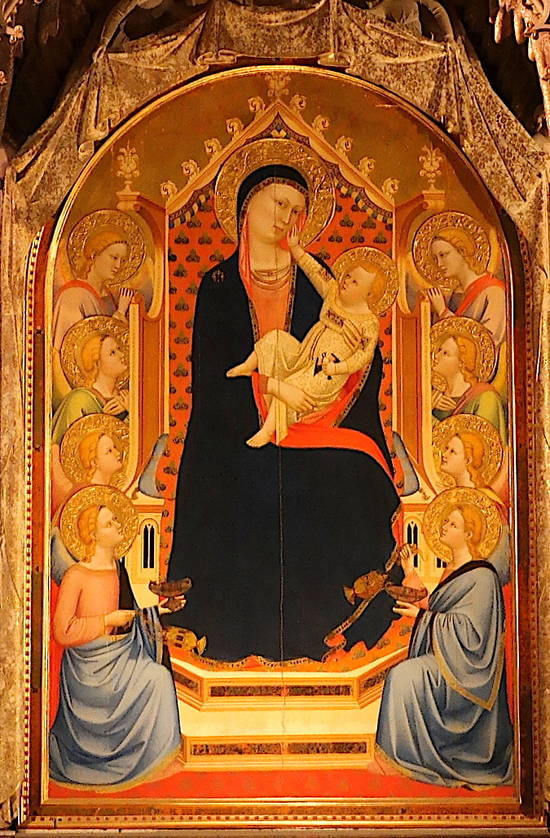
For anyone taking advantage of the relevant calm in Florence this month (when the queue outside the Accademia, the city’s most famous gallery, is usually minimal—though it is still always worth booking your visit online) there is a fascinating little exhibition now running (until 5 May)..
What brings these eight paintings and single piece of sculpture together is the fact that they have all been added to the Gallery’s holdings during the tenure of the new director, Cecilie Hollberg, in other words, over the last three years.
The early paintings are all gold-ground and each has a story to tell about its provenance and connection to other works in the Gallery’s collection. Some were in storage elsewhere in Florence, others were exported illegally and have been recovered by the police, others have been purchased. They are beautifully exhibited in a little room and there is something almost touching about them, given that they have been retrieved from oblivion, carefully dusted off and restored, and put in their historical context. None of them is of the first importance but all of them add something to the glorious history of art in Florence.
The obscurity of some pieces is underlined by the attribution of two of the works, one to the ‘Master of 1416’ and the other to the ‘Master of 1419’. The former is a copy of Bernardo Daddi’s famous Maestà in Orsanmichele, painted some 60 years earlier, showing that the Florentines of the early 15th century still considered it one of the most beautiful works in the city. The latter unidentified ‘Master’ is named after a work now in the Museum of Fine Arts in Cleveland, Ohio. The painting by him here, The Most Holy Trinity (La Santissima Trinità), shows God the Father enthroned holding an image of Christ on the Cross, with the dove of the Holy Spirit flying down towards it. The Gallery possesses another (more important) painting of the same subject, the central panel of a triptych by Nardo di Cione. The composition is very similar, but in Nardo’s work God the Father is sitting on a beautiful red-black-and-gold cloth and the Dove perches in the centre of Christ’s halo.
The Madonna of Heavenly Humility (she is seated on clouds rather than on the ground, hence the neat title) is attributed to a Master named after the Bracciolini Chapel in the church of San Francesco in Pistoia. The Child is rather oversize, but this work was considered important enough to be confiscated by the state (after it was illegally exported from Italy to Switzerland in 2003) in order to preserve it in its Tuscan context.
There are also two doors of a tabernacle known once to have been in the Corsini Palace (which still contains the most important private collection in Florence, albeit closed to the public). They are by the prolific painter Mariotto di Nardo (son of Nardo di Cione) and are of exceptional interest for their decoration in gilded pastiglia, which forms leafy frames all around a scene of the Annunciation and figures of four saints. In another work by Mariotto in the exhibition, the Coronation of the Virgin with Angels, the painter has characteristically included lots more angels in the background depicted in gold.
The newly acquired piece of sculpture is a portrait bust of Giovanni Battista Niccolini, signed in 1827 by Lorenzo Bartolini, the most important sculptor of his time. The sitter, Niccolini, was a playwright, born in Pisa in 1782 and who died in Florence in 1862. The bust will be displayed beside the original plaster cast Bartolini made for it, which together with numerous other works from his studio was already owned by the Gallery. The bust was purchased by the newly-established Friends of the Galleria dell’Accademia di Firenze, who are giving welcome support to its activities.
After the magnificent exhibition on the 14th-century fabric industry, held here early in 2018, it seems that the museum’s policy (since it certainly has no need to increase its visitor numbers), at least for the time being, will be to hold small, choice exhibitions such as this one, which do not demand huge expenditure (the cost of the entrance ticket will not be increased during these shows).
I was interested to note that in the gallery with Michelangelo’s Slaves and his St Matthew (which leads up to the tribune with the colossal David), the label on the Pietà from Palestrina has at last been changed and its attribution to Michelangelo given as ‘very doubtful’ and still an ‘open subject’ (in fact the latest edition of the Blue Guide Florence chose to ignore it). At the same time, though, a fascinating suggestion has been made on the notice: that this could be a tribute to Michelangelo by the great Baroque sculptor and architect Gian Lorenzo Bernini. One of the tasks of the Blue Guides is to ensure the information provided is up-to-date.
by Alta Macadam, author of Blue Guide Florence.






